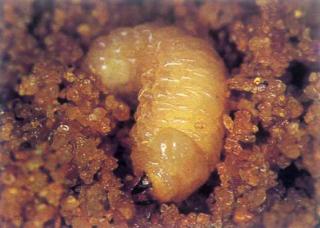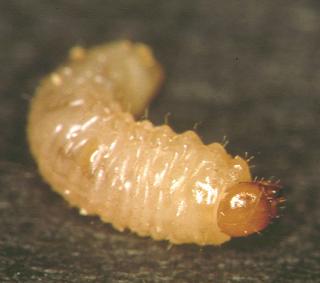How to distinguish between the beetle species
Species described
These insects are often found in the same situations and their feeding activity or damage may be confused with each other.
The beetles described include:
- African black beetle
- bronzed field beetle
- pasture beetle (Aphodius)
- vegetable beetle.
And beetles that are in the weevil group because they have a 'snout' include:
- apple weevil (curculio beetle)
- Fuller's rose weevil
- garden weevil
- sitona weevil
- small lucerne weevil
- spotted vegetable (desiantha) weevil
- subterranean clover (sub-clover) weevil
- vegetable weevil
- whitefringed weevil.
Differences in morphology of adults and larvae
Adult beetles
Adults of these beetles differ markedly. While adult weevils have a very hard outer shell, are usually flightless and have a prominent snout on the head, the beetles are also 'hard shelled', are more active fliers and do not possess a snout. Further descriptions for each adult species can be seen below.
Beetle larvae
African black beetle and pasture beetle are typically known as 'cockchafers' with larvae having:
- three pairs of legs on the thorax
- a prominent brown head with black jaws
- the body forming a C-shape with the end of the abdomen slightly enlarged.
Larvae of vegetable beetle and bronzed field beetle have the common name 'false wireworm' with larvae having:
- three pairs of legs on the thorax
- are not C-shaped
- vegetable beetle larvae have a worm like shape with shiny hard skin
- the larval stage of the bronzed field beetle are dark brown with upturned spines on the end of the body.

Weevil larvae
Weevil larvae are legless, the abdomen is not enlarged and have either:

- a white head, which makes the two black jaws very obvious - includes whitefringed weevil, small lucerne weevil and Fuller's rose weevil
or:

- a brown head - garden weevil, apple weevil, spotted vegetable weevil, vegetable weevil, sub-clover weevil and sitona weevil.

African black beetle (Heteronychus arator)
Description
Adults:
- about 12mm long
- shiny black
- slow moving
- usually found on or under the soil surface.
Larvae:
- about 35mm long and 10mm wide when fully grown
- soil dwelling
- three pairs of legs on the thorax
- prominent brown head with black jaws
- body forming a C-shape with the end of the abdomen slightly enlarged
- distinguished from other species with the naked eye, as their anal opening and associated spines are horizontal (see figure below).

Damage
Adults:
- strong fliers - mass flights sometimes occur in late summer-autumn and they are attracted to light
- feed on stems of plants near ground level killing them
- chew grass stems causing fraying. They also chew holes in potato tubers.
Larvae:
- damage grasses by root pruning.
Lesser pasture cockchafer (Aphodius frenchi)
Description
Adults:
- about 3mm long
- small, black, shiny beetle
- similar in shape to African black beetle.

Larvae:
- similar to African black beetle but much smaller.
Damage
Adult and larvae:
- are often found in pasture, but not considered to be pests
- adults very occasionally recorded damaging emerging onion seedlings.
Vegetable beetle (Gonocephalum missellum)
Description
Adults:
- about 9mm long
- matte grey, sometimes encrusted with soil on their back.
Larvae:
- about 18mm long and 2mm wide when fully grown
- three pairs of legs on thorax
- shiny, hard skin
- cylindrical/worm-like shape ('false wireworm').
Damage
Adults:
- often present in clusters and found under debris or vegetation
- feed on decaying vegetation, but known to attack seedlings
- faster moving than African black beetle.
Larvae:
- soil dwelling and feed on organic matter
- may feed on seedling horticultural crops
- can be pests of summer grown crops.
Bronzed field beetle (Adelium brevicorne)
Description
Adults:
- about 10mm long
- shiny, black beetles.
Larvae
- dark brown larvae up to 12mm long
- have upturned spines on the end of the body
- commonly known as 'false wireworms' - the same common name as larvae of vegetable beetle.
Damage
Adults:
- not crop pests
- feed on dead, decaying plant matter
- sometimes feed on leaves of plants.
Larvae:
- chew through stems of seedlings at ground level
- most destructive when they have reached half size, before the crop emerges.
Whitefringed weevil (Naupactus leucoloma)
Description
Adults:
- large grey weevil, 15mm long
- white stripe along each side and a hairy back
- black when they are wet.
Larvae:
See: Differences in morphology of adults and larvae, weevil larvae for picture.
- white-headed weevil larva, about 12mm long when fully grown
- soil inhabiting
- prominent black jaws, legless.
Damage
Adults:
- often seen feeding on sunny days
- slow moving and nibbles edges of leaves causing scalloped effect
- found in many situations, for example, gardens, orchards and pasture.
Larvae:
- soil inhabiting and can damage potato tubers, root systems of tomato, kiwi fruit and cauliflower seedlings and lucerne.
Vegetable weevil (Listoderes difficilis)
Description
Adults:
- medium sized grey weevil, 10mm long
- two short white stripes at an angle on each side of the back and a central white line on the back of its head
- this weevil can fly.
Larvae:
- about 10mm long and 3mm wide when fully grown
- brown head with brown plate behind the head
- legless
- yellow to green.
Damage
Adults:
- usually hide under vegetation during the day
- often more noticeable at edges of crops
- feed on leaves, especially brassicas.
Larvae:
- feed on above ground foliage at night
- can be found on brassicas, though rarely found on canola
- seek shelter during the day.
Sub-clover weevil (Listoderes delaguei)
Description
Adults:
- slightly smaller than vegetable weevil, about 7mm long
- brightly coloured with a smooth appearance to its body
- has a prominent white spine on each side of the back
- two angled short white stripes like vegetable weevil
- prominent white stripe running down the centre of the body just behind the head.
Larvae:
See: Vegetable weevil section for picture.
- similar to vegetable weevil larvae with brown head with brown plate behind the head
- legless
- yellow to green.
Damage
- similar habit to vegetable weevil, but little is known of its biology and pest status.
Small lucerne weevil (Atrichonotus taeniatulus)
Description
Adults:
- small to medium size weevil very similar in colour to whitefringed weevil, but much smaller, about 7mm long
- white stripe down the side not obvious as in white fringed weevils
- hairs on the back are less obvious also.
Larvae:
See: Differences in morphology of adults and larvae, weevil larvae for picture.
- white headed weevil larva
- prominent black jaws, legless
- soil inhabiting
- not easily distinguished from Fuller's rose weevil or white fringed weevil.
Damage
Adults:
- may be seen on foliage during the day, or hides under debris
- feeds on leaves, especially braissicas including canola; can damage established clover.
Larvae:
- will debilitate mature lucerne stands and damage potato tubers.
Fuller's rose weevil (Asynonychus cervinus)
Description
Adults:
- medium size weevil, about 8mm long, elongated body form
- grey with yellow stripe running across the side on first two body segments and a lateral yellow stripe on each side of the abdomen.
Larvae:
- white headed weevil larva; when fully grown, smaller than whitefringed weevil and similar size to apple weevil and garden weevil larvae
- prominent black jaws, legless
- soil inhabiting
- not easily distinguished from whitefringed weevil or small lucerne weevil.
Damage
Adults:
- seen on foliage during the day
- feed on leaves
- egg laying blocks mini-sprinklers.
Larvae:
- inhabit the soil and have damaged potato tubers.
Spotted vegetable (desiantha) weevil (Steriphus diversipes)
Description
Adults:
- small weevil, about 5mm long
- dark coloured sometimes with grey flecking on the back.
Larvae:
- brown-headed weevil larva smaller than apple weevil and garden weevil larvae when mature
- soil inhabiting
- small larvae are difficult to distiguish from garden weevil, apple weevil and sitona weevil.
Damage
Adults:
- may be seen on foliage during the day
- found in many situations, from domestic gardens to pastures.
Larvae:
- soil inhabiting and can attack vegetables, but most serious damage is to cereal seedlings.
Sitona weevil (Sitona discoideus)
Description
Adults:
- small greyish-brown weevil, about 5mm long, with three white stripes on the thorax
- strong flier.
Larvae:
- brown headed weevil larvae
- inhabit soil
- similar to garden weevil, apple weevil and spotted vegetable weevil larvae.
Damage
Adults:
- feed on leaves
- minor pest of pastures and rarely causes damage to canola.
Larvae:
- feed on grass roots
- not known to be a pest.
Apple weevil (Otiorhynchus cribricollis)
Description
Adults:
- medium size weevil, about 8mm long with a slightly bulbous abdomen
- uniform brown colouring
- rows of short hairs along its back.
Larvae:
See: Differences in morphology of adults and larvae, weevil larvae for picture.
- brown-headed weevil larva, about 10mm long and 4mm wide when mature
- bulbous abdomen
- soil inhabiting
- small larvae are difficult to distiguish from garden weevil, spotted vegetable (desiantha) weevil and sitona weevil.
Damage
Adults:
- feed at night
- found in orchards
- descends trees during the day and hides under the bark or debris and crawls back up at night
- ringbark stems below the growing tip of young trees
- feed on leaves and pedicels of fruit.
Larvae:
- inhabit the soil and have damaged potato tubers
- root feeding.
Garden weevil (Phylyctinus callosus)
Description
Adults:
- medium size weevil, about 7mm long with a bulbous abdomen
- has a prominent lighter coloured strip running across the back
- usually grey-brown colour.
Larvae:
See: Differences in morphology of adults and larvae, weevil larvae for picture.
- brown-headed weevil larva, similar in size to apple weevil
- soil inhabiting
- small larvae are difficult to distiguish from apple weevil, spotted vegetable (desiantha) weevil and sitona weevil.
Damage
Adults:
- hide during the day
- cluster in curled leaves, below deciduous trees and in crevices
- feed on any soft green plant tissue including young fruit.
Larvae:
- damage potato tubers, asparagus crown and plant roots, for example strawberry.



















